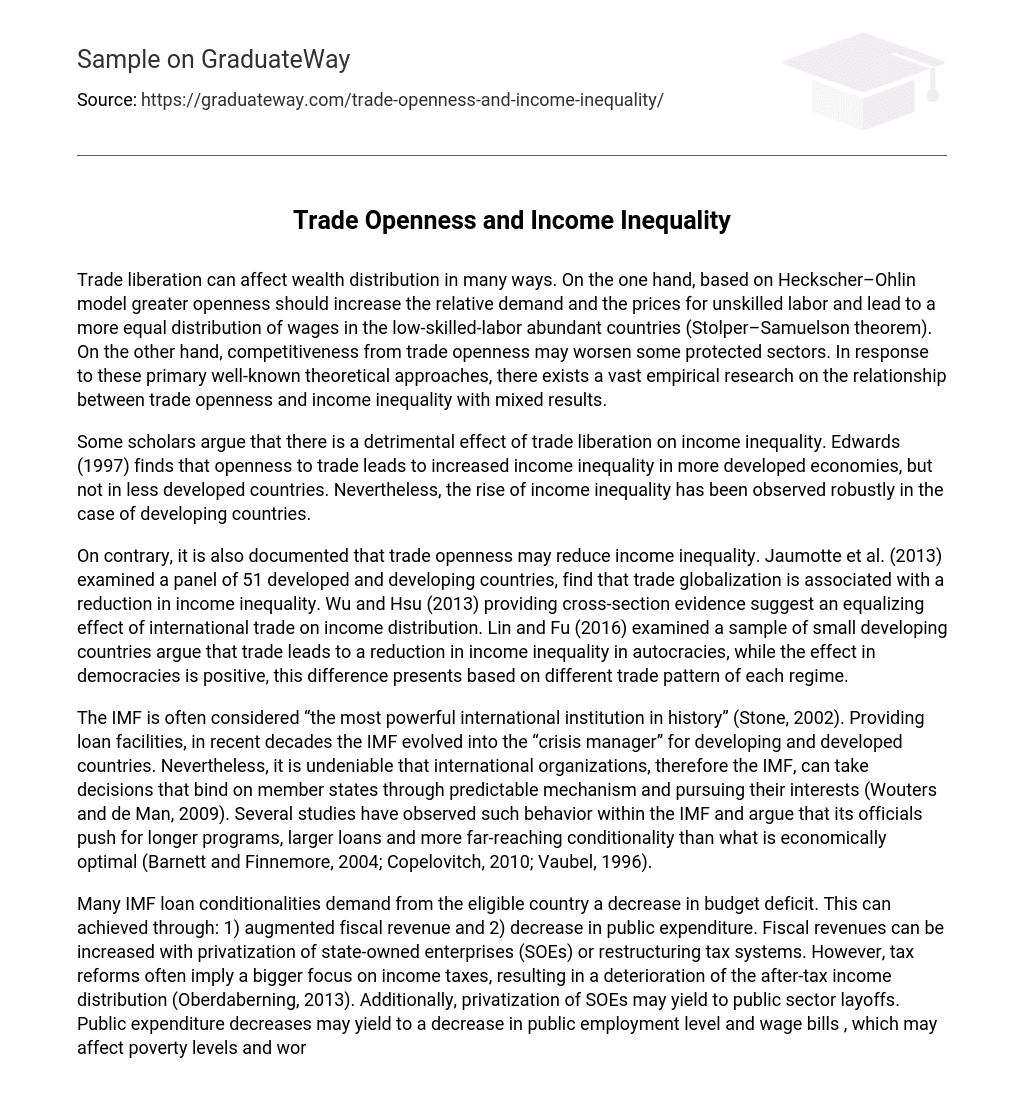Trade liberation can affect wealth distribution in many ways. On the one hand, based on Heckscher–Ohlin model greater openness should increase the relative demand and the prices for unskilled labor and lead to a more equal distribution of wages in the low-skilled-labor abundant countries (Stolper–Samuelson theorem). On the other hand, competitiveness from trade openness may worsen some protected sectors. In response to these primary well-known theoretical approaches, there exists a vast empirical research on the relationship between trade openness and income inequality with mixed results.
Some scholars argue that there is a detrimental effect of trade liberation on income inequality. Edwards (1997) finds that openness to trade leads to increased income inequality in more developed economies, but not in less developed countries. Nevertheless, the rise of income inequality has been observed robustly in the case of developing countries.
On contrary, it is also documented that trade openness may reduce income inequality. Jaumotte et al. (2013) examined a panel of 51 developed and developing countries, find that trade globalization is associated with a reduction in income inequality. Wu and Hsu (2013) providing cross-section evidence suggest an equalizing effect of international trade on income distribution. Lin and Fu (2016) examined a sample of small developing countries argue that trade leads to a reduction in income inequality in autocracies, while the effect in democracies is positive, this difference presents based on different trade pattern of each regime.
The IMF is often considered “the most powerful international institution in history” (Stone, 2002). Providing loan facilities, in recent decades the IMF evolved into the “crisis manager” for developing and developed countries. Nevertheless, it is undeniable that international organizations, therefore the IMF, can take decisions that bind on member states through predictable mechanism and pursuing their interests (Wouters and de Man, 2009). Several studies have observed such behavior within the IMF and argue that its officials push for longer programs, larger loans and more far-reaching conditionality than what is economically optimal (Barnett and Finnemore, 2004; Copelovitch, 2010; Vaubel, 1996).
Many IMF loan conditionalities demand from the eligible country a decrease in budget deficit. This can achieved through: 1) augmented fiscal revenue and 2) decrease in public expenditure. Fiscal revenues can be increased with privatization of state-owned enterprises (SOEs) or restructuring tax systems. However, tax reforms often imply a bigger focus on income taxes, resulting in a deterioration of the after-tax income distribution (Oberdaberning, 2013). Additionally, privatization of SOEs may yield to public sector layoffs. Public expenditure decreases may yield to a decrease in public employment level and wage bills , which may affect poverty levels and worsen income distribution.
Furthermore, the fact that many IMF arrangements request reductions in pensions, employment protection and more flexible labor market, also can have adverse distributional effects (Kentikelenis et al., 2016). Nevertheless, the evidence of the literature regarding the association of IMF program participation and social expenditure is ambiguous (Clements et al., 2013; Handa and King, 1997; Martin and Segura-Ubiergo, 2004; Nooruddin and Simmon, 2006).
Investigating the impacts of IMF programs on income distribution most studies find that program participation is connected to higher inequality (Garuda, 2000; Lang, 2016; Oberdaberning, 2013). More recent studies investigate the effects of IMF financial arrangements on poverty (Estearly, 2003; Makedonas et al., 2015; Oberdaberning, 2013). This literature provides conflicting evidence depending on the sample and the methodology used. Some scholars also examined a related issue, the impact of IMF agreements on labor’s share of income.
The results show a decline in income share (Pastor, 1987; Vreeland, 2001). Because of data limitation and their availability, some studies used alternatives measurements of poverty such as infant mortality and human development index. However, the evidence shows no clear-cut conclusion about the relationship between IMF engagement and poverty proxies (Hajro and Joyce, 2009; Makedonas et al., 2015; Shandra et al., 2004; Shandra et al., 2012). A detailed summary of the studies evaluating the effects of IMF programs on income inequality and poverty is provided in Table 1.
It is already considered that the influence of IMF can have winners and losers. Hence, following the above theoretical predictions, we way express our testable hypothesis as follows: Hypothesis 1 IMF programs increase the level of income inequality within countries.
It is also important to mention that the main goal of some IMF loans is “to include poverty reduction and to grant governments larger scope in negotiating the policy conditions”. These programs are: PRGF and ECF. In response to this, the theoretical considerations suggest the following hypothesis: Hypothesis 2 The effect of IMF programs, with sharply focus on poverty reduction and greater degrees of participation by civil society and national ownership, which in turn would lead to more consistent policy implementation, on income inequality is lower.





